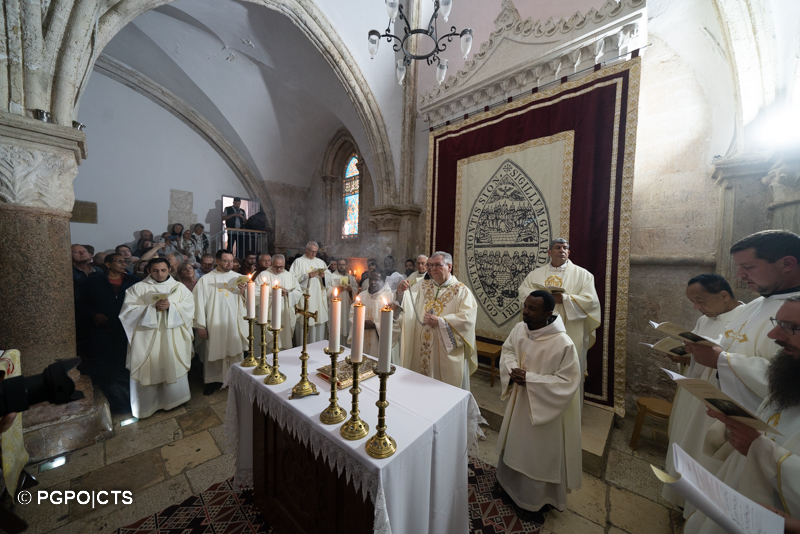
Holy Thursday in Jerusalem is full of liturgies that take place throughout the day. It marks the beginning of the Paschal Triduum, when the events of Christ’s Easter Mystery are celebrated: the establishment of the ministerial priesthood, of the commandment of brotherly love and, lastly, of the Passion.
Liturgies of Holy Thursday at the Holy Sepulchre
On Thursday morning, the liturgies of the In Cena Domini Mass and of the Chrism Mass, presided by the Latin Patriarch of Jerusalem, Mons Pierbattista Pizzaballa, were held in the Basilica of the Holy Sepulchre..
The In Cena Domini Mass at the Cenacle
In the afternoon, as tradition has it, the friars of the Custody of the Holy Land went in a procession to the room of the Cenacle, standing on Mount Zion, for the celebration of the Missa in Coena Domini.
Here at the Cenacle, where the Lord gave the fundamental law of the New Alliance, i.e. the law of reciprocal and fraternal love, the Custos of the Holy Land, Fr. Francesco Patton, commemorated Jesus’ washing of the apostles’ feet, replicating himself the same gesture of love to twelve friars.
“Let us thank the Lord because we are enjoying a unique privilege, that of being able to celebrate the memory of Easter in this large room where it was established,” began the Father Custos in his commentary on the Word.
Being together in this holy place to celebrate the Eucharist gave the Father Custos the occasion to add: “In celebrating the Lord’s Supper, we are mysteriously but really transformed by what Jesus did here on Holy Thursday, giving himself in the Eucharist, establishing the priesthood, washing the disciples’ feet and teaching the precept of love. We mysteriously become present at Christ dying on the cross and taking part in his resurrection,” as “all the Easter mystery is present in the celebration of the Last Supper,” which “reaches and transforms us” through the Eucharist.
Through the Eucharist we are already taking part in the new world that Jesus has inaugurated with his resurrection. And through the mystery of Easter we can defeat hatred “which continues to be sown in huge handfuls in the furrow of history and our humanity, including here in the Holy Land,” because it is through this experience that we are given hope.”
From the Cenacle to the Armenian churches of St James and the Holy Archangels
From the Cenacle, the friars then went to the church of St James of the Armenians and to the church of the Holy Archangels, to commemorate the hospitality received here in the 16th century. The friars were welcomed by the Armenians at the latter church for seven years, after the followers of Francis of Assisi had been expelled in 1551 from the Convent of the Cenacle where they lived. After this traditional tribute, the friars went towards the Syriac Orthodox church of St Mark, well known for having been built on the presumed house of Mary. Mother of Mark the Evangelist and which, according to tradition, would mark the exact place of the Last Supper of Jesus.
Holy Hour in Gethsemane
Lastly, in the evening of Holy Thursday the prayer of the Holy Hour of Jesus is celebrated in the garden of Gethsemane, in the place where Christ remained in a vigil of prayer before being arrested which anticipated his Passion. During the liturgy, presided by the Custos of the Holy Land, there is meditation on the three decisive episodes that characterized the night of Jesus’ arrest: the prediction by Christ of Peter’s denial and the flight of the disciples, his Agony in the olive grove and, lastly, his arrest.
When the celebration was over, the assembly went from the Basilica of the Agony in a procession to the Church of St Peter in Gallicantu, where Peter betrayed Christ.
Filippo De Grazia






